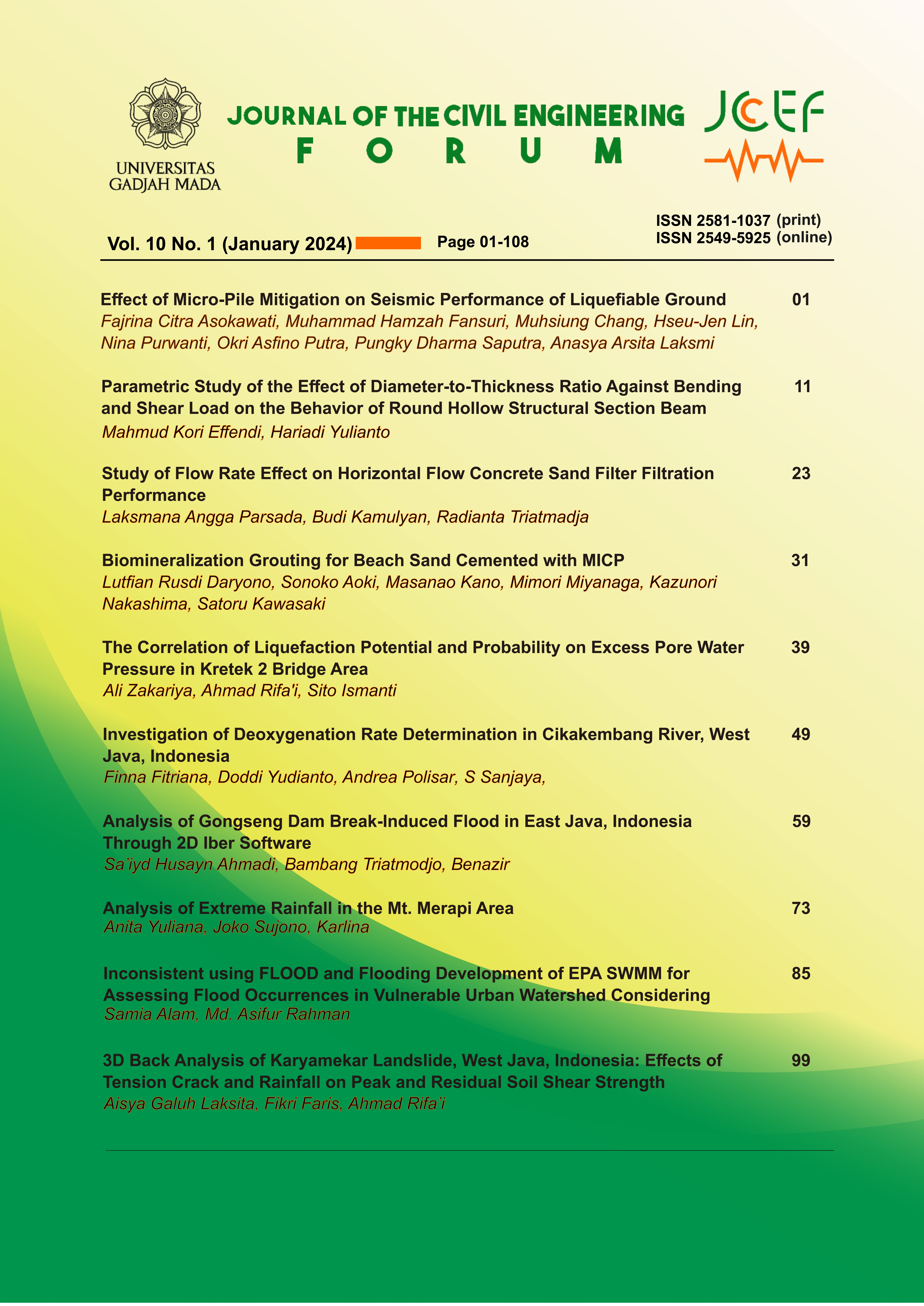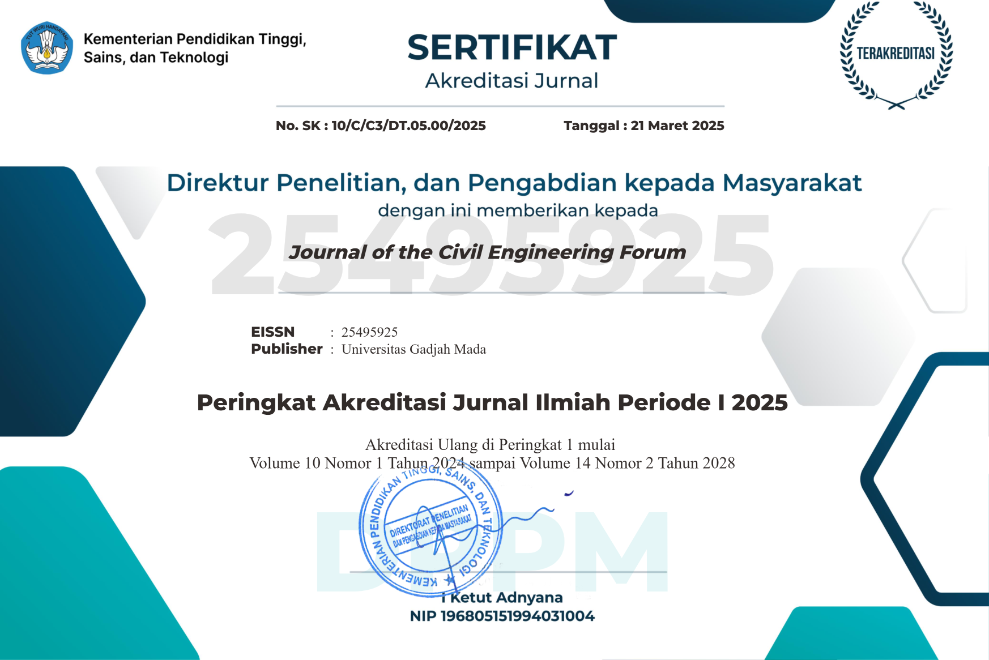Investigation of Deoxygenation Rate Determination in Cikakembang River, West Java, Indonesia
Abstract
Cikakembang River, a tributary of Citarum River, is situated in the densely populated Majalaya District, renowned for textile production. Direct discharges of domestic and industrial pollutants into the river contribute to substantial pollution, making it crucial to manage pollution levels. This implies that controlling pollution is crucial, as it significantly impacts the condition of Citarum River, already infamous as one of the world most polluted rivers. A key indicator for assessing river water quality is Biological Oxygen Demand (BOD), representing the oxygen required for microorganism-mediated decomposition. This parameter is influenced by deoxygenation rate, denoted as kd. Therefore, this study aimed to analyze the most suitable kd value for Cikakembang River using various empirical methods, including Simple, Fujimoto, Sawyer, Thomas, Fair, and Hydroscience. The result showed that Thomas method provided the most accurate prediction for BOD concentration of the river. In rainy season, Root mean square error (RMSE), mean absolute percentage error (MAPE), and coefficient of determination (R2) values were 0.542, 0.035, and 0.981, respectively, and in dry season, the values were 0.117, 0.009, and 0.999. Additionally, kd value effectively simulated the river water quality using HEC-RAS, yielding satisfactory results. RMSE, MAPE, and R2 values for BOD concentration were 3.551, 0.162, and 0.331 in rainy season and 1.071, 0.100, and 0.812 in dry season. Finally, the modeling result showed that Cikakembang River did not meet the Class 2 Water Quality Standard during both rainy and dry seasons. This finding is critical, as it underscores the severity of the pollution problem in the river and the urgent need for comprehensive and effective management strategies to improve its water quality.
References
Astuti, L. P. and Pratiwi, N. T. (2016), ‘Evaluasi metode penentuan parameter biochemical oxygen demand (BOD)’, LIMNOTEK Perairat Darat Tropis di Indonesia 23(1), 44–49.
Atima, W. (2015), ‘BOD dan COD sebagai parameter pencemaran air dan baku mutu air limbah’, Biology Science and Education 4(1), 83. URL: https://doi.org/10.33477/bs.v4i1.532
Bagchi, D. and Chaudhuri, N. (1970), ‘Simplified graphical evaluation of BOD curve constant’, Journal (Water Pollution Control Federation) 42(5), 136–139. URL: http://www.jstor.org/stable/25036585
Band, S., Heggy, E., Bateni, S., Karami, H., Rabiee, M., Samadianfard, S., Chau, K. and Mosavi, A. (2021), ‘Groundwater level prediction in arid areas using wavelet analysis and gaussian process regression’, Engineering Applications of Computational Fluid Mechanics 15(1), 1147–1158. URL: https://doi.org/10.1080/19942060.2021.1944913
Blacksmith Institute (2013), ‘The world’s worst 2013: the top ten toxic threats cleanup, progress, and ongoing challenges’.
Brunner, G. (2016), HEC-RAS river analysis system user’s manual version 5.0, U.S. Army Corps of Engineers, Institute for Water Resources, Hydrologic Engineering Center, Davis, CA, USA.
Chapra (2008), Surface water-quality modeling, Waveland Press, Inc.
Dhage, S., Dalvi, A. and Prabhu, D. (2012), ‘Reaction kinetics and validity of bod test for domestic wastewater released in marine ecosystems’, Environmental Monitoring and Assessment 184(9), 5301–5310. URL: https://doi.org/10.1007/s10661-011-2341-y
ESRI, Maxar, Geographics, E. and the GIS User Community (2023), ‘World imagery (mapserver)’. Accessed at 16 May 2022. URL: https://services.arcgisonline.com/ArcGIS/rest/services/WorldI magery/MapServer
Fair, G. (1936), ‘The ‘log-difference’ method of estimating the constants of the first-stage biochemical oxygen demand curve’, Sewage Works Journal 8(3), 430–434.
Fitriana, F., Yudianto, D., Sanjaya, S., Roy, A. V. and Seo, Y. (2023), ‘The assessment of Citarum River water quality in Majalaya District, Bandung Regency’, Rekayasa Sipil 17(1), 37–46. URL: https://doi.org/10.21776/ub.rekayasasipil.2023.017.01.6
Fujimoto, Y. (1964), ‘Graphical use of first-stage bod equation’, Journal (Water Pollution Control Federation) 36(1), 69–71.
Government Regulation No.22 of 2021 concerning the implementation of Environmental Protection and Management (2021), ‘Government regulation no. 22 of 2021 concerning the implementation of environmental protection and management’.
Hossain,et.al (2022), ‘Compressive strength prediction for industrial waste-based scc using artificial neural network’, Journal of the Civil Engineering Forum 9(January), 11–26. URL: https://doi.org/10.22146/jcef.4094
Iwasa, Y. and Aya, S. (1991), Predicting longitudinal dispersion coefficient in open-channel flows, in ‘International Symposium on Environmental Hydraulics’, pp. 505–510.
Jain, S. and Jha, R. (2005), ‘Comparing the stream re-aeration coefficient estimated from ann and empirical models’, Hydrological Sciences Journal 50(6), 1037–1052. URL: https://doi.org/10.1623/hysj.2005.50.6.1037
Jha et al. (2004), ‘A supplementary approach for estimating reaeration rate coefficients’, Hydrological Processes 18(1), 65–79. URL: https://doi.org/10.1002/hyp.1312
Kompas (2011), ‘Majalaya, seabad geliat tekstil rakyat’. Ministry of Environment and Forestry (2018), ‘KLHK jelaskan penanganan pencemaran Sungai Citarum, Cisadane dan Ciujung’. Accessed at 13 April 2023. URL: http://ppid.menlhk.go.id/siaran_pers/browse/1643
Ministry of Industry Indonesia (2014), ‘Jabar jantung industri nasional’. Accessed at 13 April 2023.
Nas, S., Bayram, A., Nas, E. and Bulut, V. (2008), ‘Effects of some water quality parameters on the dissolved oxygen balance of streams’, Polish Journal of Environmental Studies 17(4), 531–538. National Geographic Indonesia (2011), ‘Jawa Barat penyumbang limbah B3 terbesar di Indonesia’.
Peruzzi, C., Galli, A., Chiaradia, E. and Masseroni, D. (2021), ‘Evaluating longitudinal dispersion of scalars in rural channels of agro-urban environments’, Environmental Fluid Mechanics 21(4), 925–954. URL: https://doi.org/10.1007/s10652-021-09804-7
Polisar, A. (2023), ‘Studi dampak limbah buangan domestik dan industri tekstil pada Sungai Cikakembang, Majalaya, Kabupaten Bandung’.
Statistics Indonesia (2021), ‘Berita resmi statistik: hasil sensus penduduk 2020’.
Thomas Jr., H. (1950), ‘Graphical determination of bod curve constants’, Water & Sewage Works 97(3), 123.
Wahyuningsih, S., Novita, E. and Satya, I. (2021), ‘Daya tampung sungai rembagan terhadap beban pencemaran menggunakan metode streeterphelps’, Jurnal Teknik Pertanian Lampung (Journal of Agricultural Engineering) 10(2), 209. URL: https://doi.org/10.23960/jtep-l.v10i2.209-219
Yustiani, Y., Abror, D., Wahyuni, S. and Nurkanti, M. (2021), ‘Determination of deoxygenation rate of Citarum River water using long term technique’, Journal of Environmental Treatment Techniques 9(2), 505–509. URL: https://doi.org/10.47277/jett/9(2)509
Yustiani, Y., Wahyuni, S., Ayudina, A., Nurkanti, M. and Suliasih, N. (2019), ‘Determination of deoxygenation rate coefficient as a component in water quality modeling of the middle segment of Citarum river, Indonesia’, International Journal of Recent Technology and Engineering 8(2), 1057–1061. URL: https://doi.org/10.35940/ijrte.B1844.078219
Copyright (c) 2024 The Author(s)

This work is licensed under a Creative Commons Attribution-ShareAlike 4.0 International License.
Copyright is granted to authors for the purpose of providing protection for articles written to describe experiments and their results. JCEF will protect and defend the work and reputation of the author and are also willing to address any allegations of violation, plagiarism, fraud, etc. against articles written and published by JCEF. JCEF is published under the terms of the Creative Commons Attribution-ShareAlike 4.0 International License (CC BY-SA 4.0). The author holds the copyright and assigns the journal rights to the first publication (online and print) of the work simultaneously.






